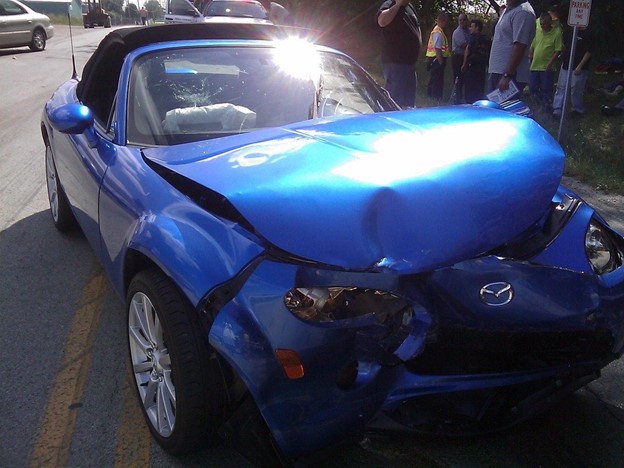The idea that you may not see a vehicle right next to you in broad daylight may seem to defy common sense. But it is one of the realities of driving. Blind spots are real. They are parts of the road that you can’t see by looking through your windscreen, rear-view, and side-view mirrors. And even the most seasoned drivers never feel completely comfortable with blind spots. After all, they pose a real and constant threat to your safety on the road.
In this post, we delve into the topic of blind spots and what are the hidden dangers and liabilities associated with auto accidents resulting due to blind spots. So let’s get started.
Blind Spots – Overview
To get started, blind spots are any part of the road or any area around your vehicle that you cannot see using your side and rear-view mirrors or while looking straight ahead through your windscreen. But you may be able to see these areas around your vehicle only when you turn your head.
But why do blind spots arise?
Firstly, your rear-view and side mirrors offer you a limited field of view. To what extent you can see around your vehicle is determined by the mirror’s shape, size, and curvature. So technically, anything that lies outside that field is not visible to the driver. Secondly, the car’s structure, such as the frame, hood, roof, trunk, or trailer, can also block the driver’s view. Lastly, the content inside the car, including the cargo, seats, and even the passengers, can block a driver’s view and create one.
Now that you know what leads to a blind spot, you must be wondering how large these areas can be? The dimensions typically depend on the following factors.
- The dimensions of the vehicle,
- The content the vehicle is carrying,
- Weather conditions,
- Road conditions, including the curvature of the roads,
- The height, alertness, and visual acuity of the driver.
Essentially every vehicle on the road has them. However, the location and dimensions of these areas can vary significantly depending on the factors highlighted above.
Now let’s look at the hidden dangers and liability of blind spots.
The Hidden Dangers of Blind Spots
Blind spots can pose a threat to the vehicle, driver, and passengers in several ways. Let’s look at the hidden dangers.
You Can’t See, and the Other Driver Can’t See You.
One of the worst things that can happen on the road is when you can’t see what’s around you. But what’s more terrible is that the other driver can’t see you. And when that is the case, both the drivers do not know which direction they should move and when the driver does not see the hazard in their blind spots, it can significantly increase the risk of collision.
Some of the common blind spot collisions include
- Sideswipe Collisions – Collision between two vehicles when one of the drivers changes the lane without seeing a vehicle in his blind spot,
- T-Bone Collisions – When one of the vehicles collides with the side of another, a faster-moving vehicle that is trying to pass in its blind spot,
- Under-ride Accidents – When a semi-truck changes the lane next to a smaller vehicle and traps it under its trailer.
You Have to Rely on Your Estimate (Which May Go Wrong)
In case of a blind spot, the driver has to rely on guesswork to estimate the size and shape of another vehicle when driving near them. And since it is an estimate, a car collision is the only outcome in case the estimate goes wrong.
Driver Distraction
Another possible hidden danger is driver distraction. When there is a blind spot, it often forces the driver to turn their head and see what’s around them. As a result, they take off their focus from the mirrors, which essentially blinds them off the road so they can’t see what lies ahead. Taking your focus off the road for a few split seconds is another major factor in car accidents. On roads and highways, where you are driving at high speed, driver distraction is one of the causes of multiple vehicle collisions.
Overcorrection
Drivers who become aware of their blind spot may go for overcorrection, another potential danger that can lead to auto accidents. Even the most experienced drivers may panic when they check their blind spot, and they may react by suddenly jerking the steering wheel or slamming on the brakes. These reactions or overcorrections can put the vehicle, driver, and passengers at risk of collision.
Fatal Auto-Accidents
While negligent driving is one of the leading causes of fatal auto accidents, an accident resulting from blind spots can also be fatal for the driver and the passengers.
Now that you know the hidden dangers, let’s look at the liability for these auto accidents.
The Liability for Accident Resulting Due to Blind Spots
As a person driving on the road, it is the primary responsibility of the drivers to check their side and rear-view mirrors. Moreover, they also need to turn their heads while switching lanes to ensure vehicles are in their blind spot. When the driver is switching lane attempts to do so after checking the blind spot, the liability falls on the driver who fused into a blind spot.
On the other hand, when the driver switches lanes without checking and hits the vehicle. As a result, the liability falls on the driver.
Many drivers assume the blame for blind spot accidents and think that their car accident is a result of their negligence, but it’s best to avoid relying solely on your assumption. A better approach is to work with an experienced lawyer who can objectively evaluate your rights and help you decide whether you should pursue compensation for the damage. Your lawyer may need the following evidence to build your case.
- Contact information of the witness,
- Medical reports and bills,
- Photos from the accident scene and of the damaged vehicle, and
- Police report.
Your lawyer may ask for more evidence if they need any more information. The sooner you get to the lawyer and give them the evidence they need, the better it is.
Final Words
Even the best and most experienced drivers cannot completely eradicate the risk of blind spot accidents. However, by knowing the hidden dangers and liability of them, you can be better positioned to find the right legal assistance to help you deal with auto accidents resulting from blind spots.


